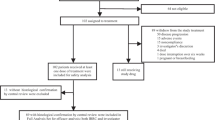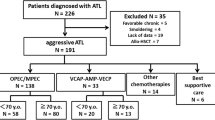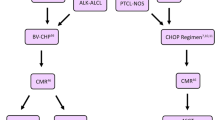Abstract
Peripheral T cell lymphomas account for approximately 10 % of all the non-Hodgkin lymphomas and are characterized by an aggressive clinical course and poor treatment outcome. In contrast to the improvement in the treatment of B cell lymphomas, there is no established standard chemotherapy regimen for relapsed/refractory T cell lymphomas. Our institute introduced modified ESHAP (mESHAP) regimen to reduce renal toxicity of standard ESHAP therapy, in which cisplatin was switched to carboplatin. We retrospectively analyzed the efficacy of mESHAP against relapsed/refractory T cell lymphomas. Twenty-two patients with relapsed/refractory T cell lymphomas were treated with mESHAP regimen at the University of Tokyo Hospital between January 2001 and December 2012. The median age was 59 years (range, 36–77). The diagnosis comprised peripheral T cell lymphoma, not otherwise specified (n = 10), angioimmunoblastic T cell lymphoma (AITL; n = 9), mycosis fungoides (n = 1), and anaplastic lymphoma kinase (ALK)-negative anaplastic large cell lymphoma (n = 2). The median follow-up period was 9.5 months (range, 2.5–62.3). Complete remission (CR) was achieved in four patients (18 %) and partial remission (PR) in three patients (14 %). The median overall survival (OS) and progression-free survival (PFS) were 11.0 and 2.5 months, respectively. Leukopenia was the most frequent side effect and renal impairment was rare. According to a multivariate analysis, better OS and PFS were recorded in patients without bone marrow invasion (OS, hazard ratio (HR) 0.13, p = 0.0079; PFS, HR 0.13, p = 0.0044) or those with AITL (OS, HR 0.21, p = 0.021; PFS, HR 0.15, p = 0.0043). Although overall outcomes of mESHAP for relapsed/refractory T cell lymphomas were not excellent, this regimen remains one of the possible candidates for those with AITL histology or without bone marrow invasion


Similar content being viewed by others
References
Vose J, Armitage J, Weisenburger D, Project IT-CL (2008) International peripheral T-cell and natural killer/T-cell lymphoma study: pathology findings and clinical outcomes. J Clin Oncol 26(25):4124–4130
Savage KJ, Chhanabhai M, Gascoyne RD, Connors JM (2004) Characterization of peripheral T-cell lymphomas in a single North American institution by the WHO classification. Ann Oncol 15(10):1467–1475
Horwitz S, Moskowitz C, Kewalramani T, Hamlin P, Straus D, O'Connor O, Noy A, Portlock C, Nimer S, Palomba ML, Zelenetz A (2005) Second-line therapy with ICE followed by high dose therapy and autologous stem cell transplantation for relapsed/refractory peripheral T-cell lymphomas: minimal benefit when analyzed by intent to treat. Blood 106(11):abstract 2679
Velasquez WS, McLaughlin P, Tucker S, Hagemeister FB, Swan F, Rodriguez MA, Romaguera J, Rubenstein E, Cabanillas F (1994) ESHAP–an effective chemotherapy regimen in refractory and relapsing lymphoma: a 4-year follow-up study. J Clin Oncol 12(6):1169–1176
Ueda K, Nannya Y, Asai T, Yamamoto G, Hangaishi A, Takahashi T, Imai T, Kurokawa M (2010) Efficacy and safety of modified rituximab-ESHAP therapy for relapsed/refractory B-cell lymphoma. J Chemother 22(1):54–57
(1993) A predictive model for aggressive non-Hodgkin's lymphoma. The International Non-Hodgkin's Lymphoma Prognostic Factors Project. N Engl J Med 329 (14):987–994
Lister TA, Crowther D, Sutcliffe SB, Glatstein E, Canellos GP, Young RC, Rosenberg SA, Coltman CA, Tubiana M (1989) Report of a committee convened to discuss the evaluation and staging of patients with Hodgkin's disease: cotswolds meeting. J Clin Oncol 7(11):1630–1636
Cheson BD, Horning SJ, Coiffier B, Shipp MA, Fisher RI, Connors JM, Lister TA, Vose J, Grillo-López A, Hagenbeek A, Cabanillas F, Klippensten D, Hiddemann W, Castellino R, Harris NL, Armitage JO, Carter W, Hoppe R, Canellos GP (1999) Report of an international workshop to standardize response criteria for non-Hodgkin's lymphomas. NCI Sponsored International Working Group. J Clin Oncol 17(4):1244
Calvert AH, Newell DR, Gumbrell LA, O'Reilly S, Burnell M, Boxall FE, Siddik ZH, Judson IR, Gore ME, Wiltshaw E (1989) Carboplatin dosage: prospective evaluation of a simple formula based on renal function. J Clin Oncol 7(11):1748–1756
Uni M, Yoshimi A, Nakamura F, Takazawa Y, Fukayama M, Kurokawa M (2013) Successful allogeneic stem cell transplantation for Lennert lymphoma. Ann Hematol 92(6):859–860
Non-Hodgkin's Lymphomas Guideline (Version 2.2014) National Comprehensive Cancer Network. http://www.nccn.org/professionals/physician_gls/pdf/nhl.pdf. Accessed 30 June 2014
Zelenetz AD, Hamlin P, Kewalramani T, Yahalom J, Nimer S, Moskowitz CH (2003) Ifosfamide, carboplatin, etoposide (ICE)-based second-line chemotherapy for the management of relapsed and refractory aggressive non-Hodgkin's lymphoma. Ann Oncol 14(Suppl 1):i5–i10
Park SH, Kim S, Ko OB, Koo JE, Lee D, Jeong YP, Huh J, Kim SB, Kim SW, Lee JL, Suh C (2006) ESHAP salvage therapy for refractory and relapsed non-Hodgkin's lymphoma: a single center experience. Korean J Intern Med 21(3):159–164
Zinzani PL, Venturini F, Stefoni V, Fina M, Pellegrini C, Derenzini E, Gandolfi L, Broccoli A, Argnani L, Quirini F, Pileri S, Baccarani M (2010) Gemcitabine as single agent in pretreated T-cell lymphoma patients: evaluation of the long-term outcome. Ann Oncol 21(4):860–863
Arkenau HT, Chong G, Cunningham D, Watkins D, Sirohi B, Chau I, Wotherspoon A, Norman A, Horwich A, Matutes E (2007) Gemcitabine, cisplatin and methylprednisolone for the treatment of patients with peripheral T-cell lymphoma: the Royal Marsden Hospital experience. Haematologica 92(2):271–272
O'Connor OA, Pro B, Pinter-Brown L, Bartlett N, Popplewell L, Coiffier B, Lechowicz MJ, Savage KJ, Shustov AR, Gisselbrecht C, Jacobsen E, Zinzani PL, Furman R, Goy A, Haioun C, Crump M, Zain JM, Hsi E, Boyd A, Horwitz S (2011) Pralatrexate in patients with relapsed or refractory peripheral T-cell lymphoma: results from the pivotal PROPEL study. J Clin Oncol 29(9):1182–1189
Coiffier B, Pro B, Prince HM, Foss F, Sokol L, Greenwood M, Caballero D, Borchmann P, Morschhauser F, Wilhelm M, Pinter-Brown L, Padmanabhan S, Shustov A, Nichols J, Carroll S, Balser J, Balser B, Horwitz S (2012) Results from a pivotal, open-label, phase II study of romidepsin in relapsed or refractory peripheral T-cell lymphoma after prior systemic therapy. J Clin Oncol 30(6):631–636
Foss F, Advani R, Duvic M, Hymes KB, Intragumtornchai T, Lekhakula A, Shpilberg O, Lerner A, Belt RJ, Jacobsen ED, Laurent G, Ben-Yehuda D, Beylot-Barry M, Hillen U, Knoblauch P, Bhat G, Chawla S, Allen LF, Pohlman B (2014) A Phase II trial of Belinostat (PXD101) in patients with relapsed or refractory peripheral or cutaneous T-cell lymphoma. Br J Haematol. doi:10.1111/bjh.13222
Horwitz SM, Advani RH, Bartlett NL, Jacobsen ED, Sharman JP, O'Connor OA, Siddiqi T, Kennedy DA, Oki Y (2014) Objective responses in relapsed T-cell lymphomas with single-agent brentuximab vedotin. Blood 123(20):3095–3100
Ogura M, Ishida T, Hatake K, Taniwaki M, Ando K, Tobinai K, Fujimoto K, Yamamoto K, Miyamoto T, Uike N, Tanimoto M, Tsukasaki K, Ishizawa K, Suzumiya J, Inagaki H, Tamura K, Akinaga S, Tomonaga M, Ueda R (2014) Multicenter phase II study of mogamulizumab (KW-0761), a defucosylated anti-cc chemokine receptor 4 antibody, in patients with relapsed peripheral T-cell lymphoma and cutaneous T-cell lymphoma. J Clin Oncol 32(11):1157–1163
Acknowledgments
The authors have nothing to acknowledge.
Conflict of interest
This is not a sponsored trial, but we declare the potential COI with the pharmaceutical companies that deal with the drugs used in this study. YK reports no conflicts of interest; AY reports that he is a member of the technical advisory board for Nippon Kayaku Co., Ltd.; KU reports no conflicts of interest; YN reports grant from Pfizer Japan Inc. and Nippon Shinyaku Co., Ltd. and served as a member of advisory board of Bristol-Myers Squibb; MI reports grant from Pfizer Japan Inc.; FN reports no conflicts of interest; MK reports grants from Pfizer Japan Inc., grants and honorarium for speaking engagement from Nippon Shinyaku Co., Ltd., grant and honoraria for speaking engagement from Bristol-Myers Squibb Company. MK also reports that he is a member of the technical advisory board of Bristol-Myers Squibb Company.
Author information
Authors and Affiliations
Corresponding author
Rights and permissions
About this article
Cite this article
Kogure, Y., Yoshimi, A., Ueda, K. et al. Modified ESHAP regimen for relapsed/refractory T cell lymphoma: a retrospective analysis. Ann Hematol 94, 989–994 (2015). https://doi.org/10.1007/s00277-015-2309-z
Received:
Accepted:
Published:
Issue Date:
DOI: https://doi.org/10.1007/s00277-015-2309-z




